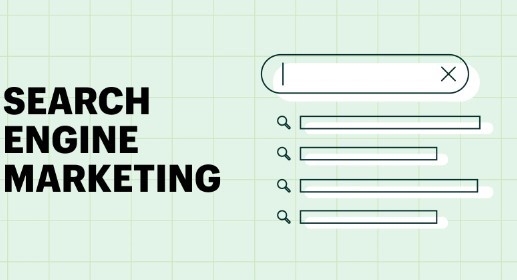Online shopping is growing year after year, and SEM plays a vital role in this growth. Most of your new visitors will come to you after searching on a search engine. You’re more likely than not to see your product when your target audience uses commercial keywords. And according to the Local SEO New York agencies survey an approved keyword research can make this possible by the deep keyword research. These shoppers are in a buying phase, unlike social media, where they are still in the discovery stage.
What exactly is search engine marketing (SEM)?
It is a digital strategy that increases the web visibility in search engine result pages. However, the term is now almost exclusively associated with paid search advertising.
Pay-per-click or paid search is another name for search engine marketing.
Why is SEM so important?
As more consumer’s research and shop for products online, it has become an important online marketing tool. As consumers are searching for information that is commercial when they enter their search query, this puts them in a better state of mind than users of other sites, such as social media, who are not explicitly looking for anything.
Search marketing reaches the consumer at just the right moment: when they’re open to receiving new information. PPC advertising does not disrupt users’ tasks and is less intrusive than most digital advertising.
With SEM, results are instant. SEM is the fastest way to increase traffic to a site.
Basics of Search Engine Marketing
Search engine marketing relies on a handful of fundamental principles.
Keywords (KWs)
Keyword research helps you determine what terms people are actually typing into Google to trigger your ads.
Keywords can be very specific (show me only when someone types “athletic size 12 tennis shoes”) or broad (show me my ad if anyone types any phrase including “tennis shoe”).
Pay-per-click (PPC)
Google launched AdWords with a compelling value proposition: you only pay when someone clicks on your ad. SEM is no longer always measured by the cost per click.
What is search engine marketing?
Google AdWords has brought about two major revolutions in advertising: auction-based marketing and search intent targeting. Understanding SEM requires understanding two different frameworks.
Search intent
Search intent is the starting point for marketers when they build SEM campaigns. It is important to define two things.
A search for “fun outdoor activities” may indicate that the user is interested in buying tennis shoes, but not necessarily at the time they search.
This search is not for buying tennis shoes but to use them and possibly exercise in them. A search like “best tennis shoe for narrow feet size 10”, however, indicates that a user is closer to purchasing a product because they are more specific in their search. This search is deemed to have a high search intent for purchasing tennis shoes.
SEM marketers build their campaigns by targeting the highest search intents possible. They create ad groups that target either “branded” terms (their brand or those of their competitors, like “Nike Tennis Shoes”) or very specific “unbranded” (sometimes called “nonbranded”) searches for their products and services (e.g. “athletic tennis shoe”).
Auction-based Advertising
Google’s auction-based bid system was the second revolution. Advertisers buy ad spaces in regular advertising. The company will set a price for the ad (for instance, $10,000 for a 30-second TV ad).
Google has billions of different advertising spaces (Google processes over five billion searches a day), and each one has its purpose, as well as the number of people who search it every month. It couldn’t set a rate for just one result.
Google instead created an auction-based model. Google runs an ad auction in real time every single time you do a Google search. It then “awards’ each ad spot on that particular search to a specific advertiser based on the results of the auction.
It’s awarded, unlike a normal auction, not to the highest bidder. The highest bidder per click is combined with the ad ranking, or “Quality Score,” Google’s proprietary metric to evaluate ad quality.
Google’s algorithm is akin to an auctioneer awarding a painting to a bidder whose house they believe it will look the best in. SEM marketers are tasked with creating compelling landing pages and ads to match their keywords in order to get a high-quality score (and a low cost per click).
How do you develop a SEM STRATEGY?
We’ve outlined seven steps that you can take to develop an SEM strategy.
1. Set clear goals: What action do you expect a user to take after clicking on your ad at the top of a SERP? You want the user to download an app or buy a product. What are your KPIs and OKRs? You can achieve your SEM goals by having a clear idea of what you expect customers to do when they arrive at your website or product.
2. Do some research before placing your bids. Assessing the paid search landscape for your category is important. Find out which ads rank highly for keywords within your category.
3. Choose a PPC search engine. Different engines have different prices. PPC rates can be high for some engines, even though they have higher search volume.
4. The key to success in PPC campaigns is selecting the best keywords. You’ll select keywords based on your goals. Find out more about keyword strategies.
5. Budget: SEM is expensive. Before you spend, research and establish your advertising budget. Some businesses consult PPC advertising agencies for guidance on SEM budgeting.
6. Creative ads can help you to attract more viewers. Consider the copy you use in your ads and how it will make your brand stand out.
7. SEM is only sometimes instantaneous. It can take time for results to appear. If you are not getting the results you desire, you can change your SEM strategy or keywords, as well as your budget.
Conclusion
SEM can help brands increase awareness. The higher an ad appears or ranks on search engines, the more likely it is that audiences will see the ad. Top SERPs help brands build awareness, trust, and consideration.
SEM’s ultimate goal is to increase the visibility of a website by using various techniques and strategies that generate more audience traffic. Marketers can use paid search, organic search rankings, and contextual advertising to increase the visibility of their websites.
SEM offers better conversion rates and click-through rates than passive marketing methods. Its PPC model allows brands to tailor campaigns easily and focuses on specific keywords in order to reach the right audience.


